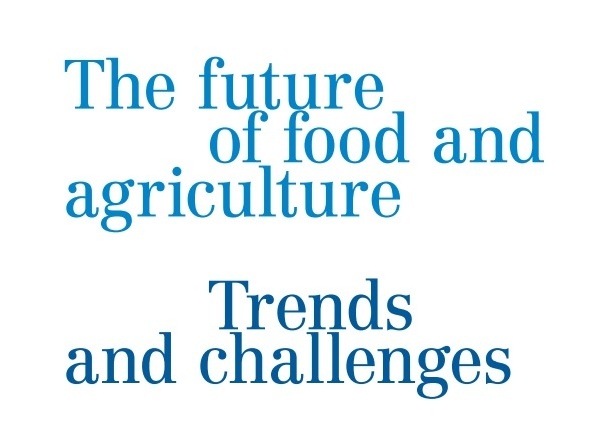The future of food and agriculture : a new FAO publication


How can we achieve FAO’s original vision of a world free from hunger and malnutrition? By focusing on this issue, a new FAO publication 'The future of food and agriculture. Trends and challenges' (2017) has put together a broad range of technical expertise and good practices of the FAO reflected in data collected to make appropriate conclusions that are supported by the evidence and analysis of the report.
___________________________________________________________________________________________________
This publication goes beyond the needs of the FAO Medium Term Plan to addressing the needs of a wider part of stakeholders who are interested in or working on themes surrounding food and agriculture. The report was undertaken for the quadrennial review of the FAO Strategic Framework and in preparation for the Organization’s Medium-Term Plan 2018-2021.
The publication raises:
- awareness on a number of trends which pose a series of challenges that agriculture and food systems are facing now and throughout the 21st century;
- issues that need stakeholders' attention;
- actions that must be taken now.
The most important challenges highlighted by this multi-disciplinary report are the following:
- Permanently eliminating hunger, malnutrition and extreme poverty also requires building resilience to protracted crises, disasters and conflicts, and preventing conflicts by promoting inclusive and equitable global development.
- Needed are innovative systems that protect and enhance the natural resource base, while increasing productivity.
- Needed is a transformative process towards ‘holistic’ approaches, such as agroecology, agro-forestry, climate-smart agriculture and conservation agriculture, which also build upon indigenous and traditional knowledge.
- Vertically coordinated, more organized food systems need to be accompanied by responsible investments and concern for smallholder livelihoods, the environmental footprint of lengthening food supply chains, and impacts on biodiversity.
- Technological improvements, along with drastic cuts in economy-wide and agricultural fossil fuel use, would help address climate change and the intensification of natural hazards, which affect all ecosystems and every aspect of human life.
- Greater international collaboration is needed to prevent emerging transboundary agriculture and food system threats, such as pests and diseases.
- Social protection combined with pro-poor growth will help meet the challenge of ending hunger and addressing the triple burden of malnutrition through healthier diets.
- What emerges is that “business as usual” is no longer an option but calls for major transformations in agricultural systems, in rural economies and in how we manage our natural resources.
The Sustanaible Development Goals (SDGs) address key world problems reflected in these challenges. How can we live in a sustainable world by 2030? To tackle this question, FAO also takes into account the trends and challenges for food and agriculture in the future.
The report highlights how FAO is working more and more on assessing the outcomes - for food and agriculture - of various scenarios regarding changes in the socio-economic and agro-ecological context. Consequently, outcomes and insights covered by the report could be taken into account to shape policy and really make a difference for agri-food sector in the future.
Anyhow, "There is no single, harmonized methodology available for collecting data on the causes and impacts of natural disasters specifically in the agriculture sector. Data collection, monitoring and reporting on impacts at the subnational and national level need to be improved and harmonized across countries, to better inform sustainable development planning", - Report, p.68 "Other areas requiring improved governance include: ... providing open access to data and statistics to enhance the role of all stakeholders in governance", - Report, p.144. |
Read and download the Full Report HERE.
___________________________________________________________________________________________________
Related content:
- MOOC (20 March-21 May): Feeding a Growing Planet: Agriculture, Nutrition and Sustainability (AIMS)
- The way forward : Global Action Plan for Sustainable Development Data (AIMS)
- How the Sustainable Development Goals will help us achieve Zero Hunger (AIMS)
- Farming First: A Global Coalition for Sustainable Agricultural Development (AIMS)
- Data Revolution for Agriculture: putting data to work for farmers and delivering benefits (AIMS)
- The Global Partnership on Sustainable Development Data (AIMS)
- 230 Indicators Approved for SDG Agenda (AIMS)

